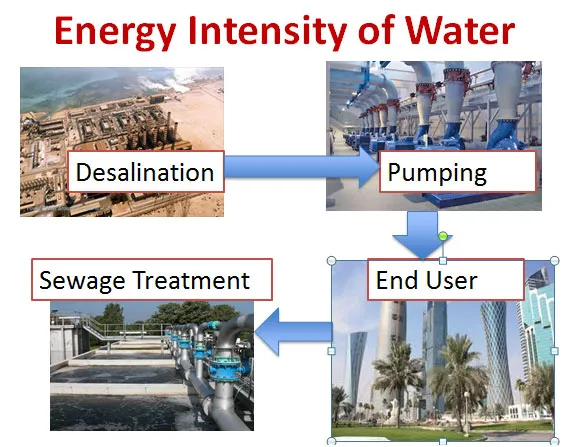Introduction:
The contents of this article is applicable for all parts of the world. However, the facts and figures presented here are from the experience gathered in GCC countries which has some unique characteristics like climate, culture etc
Water Efficiency and Conservation is getting more significant day-by-day for the following reasons:
1. Depleting natural water sources
2. Contamination of water bodies
3. Energy use associated with water
4. Increasing load on municipal water supply system
5. Increasing load on sewage treatment plants
6. Increasing water cost
Benefits of Water Conservation:
Many water conservation measures in new developments and buildings have the potential have a big life cycle savings with minimum or no investment.
In existing buildings water conservation measures are low hanging fruits with attractive payback period.
Water conservation has a significant contribution towards achieving Green Building Certification like LEED, GSAS, Estidama Pearl etc.
For example in GSAS(the Green Building rating system in Qatar). Water Conservation have a weightage of 14%. A score of 3 can be easily achieved in Water Category in the scale of -1 to 3. In most LEED Rating systems 11 points are awarded for Water Efficiency Category.
In this series of articles we will discuss,
Part 1: Energy Intensity of water in GCC countries
Part 2: Water Efficiency –Indoor: Choosing the right flow rate for the Plumbing fixtures & Water conservation in existing plumbing fixtures
Part 3: Water conservation in Landscaping
Part 4: Water Conservation in cooling tower
Part 1: Water Conservation: Energy Intensity of Water
In general, water efficiency and conservation is not given much importance compared to energy efficiency. But there is an increasing awareness on water conservation in recent years. Thanks to GSAS, LEED and other Green Building rating system. In this part of the article we will discuss about the Energy Intensity of water through its cycle.
The water use cycle (Fig 1)in GCC has the following stages:
a. Desalination
b. Pumping to reservoir
c. Pumping to water network
d. Used by consumer
e. Sewage network
f. Sewage treatment plant
Let us discuss these stages in detail,
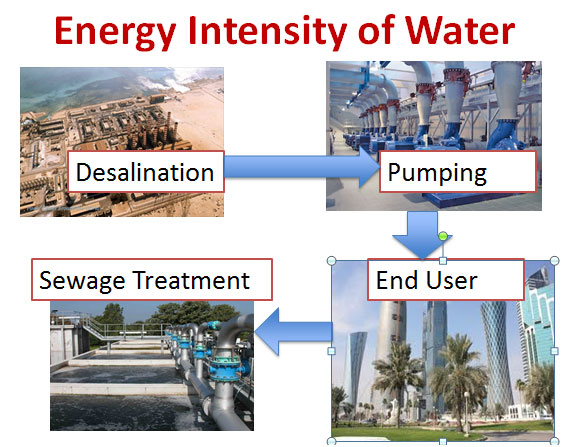
Desalination Process:
In GCC countries, Sea water is the main source of water. It has been desalinated and supplied through the municipal water supply system. Desalination is the process of removing salt from the sea water. There are three technologies commonly used in GCC countries
- Multi Stage Flashing- Cogeneration(MSF)
- Multi Effect Distillation –Cogeneration(MED)
- Reverse Osmosis
The first two technologies MSF and MED are more common compared to RO. The cogeneration plants use waste heat from power plants to desalinate. MED is comparatively less intensive to MSF. The older plants use MSF and the modern plants use MED.
The Energy Intensity of the three desalination technologies are shown in Fig 2.
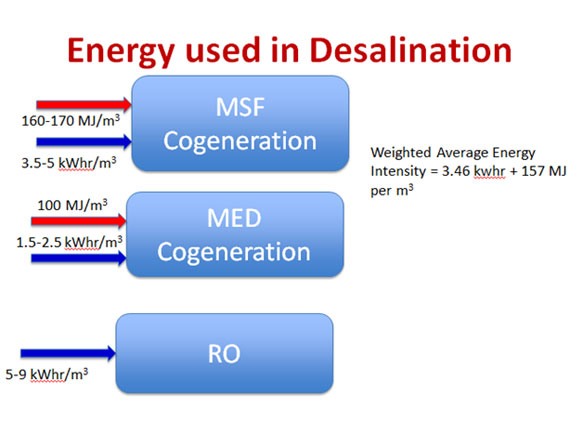
Fig 3 Shows the number of desalination plants in Middle East and the technology used, it is evident that around 2/3rd of the desalination plants use MSF technology. Based on weighted average energy intensity of desalination plant will be around 3.46kwh of electricity plus 157 MJ of thermal energy per m3 of desalinated water.
Desalination also produces hot concentrated salt called a brine which is discharge to sea causing marine pollution.
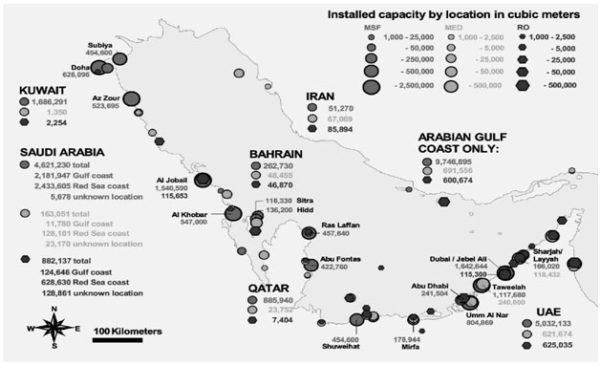
Pumping of desalinated water:
The desalination plants are generally located far away from town. So the desalinated water has to be pumped to the reservoirs in the city. Again from the reservoir it has to be pumped into domestic water network. The domestic water network can run to few thousand kilometers.
With the following assumptions of pumping energy use
- Energy Use in Pumping per 100m vertical – 0.36 kwhr/ m3
- Energy Use in Pumping per 100km horizontal – 0.04 kwhr/ m3
- We can conservatively consider the pumping energy in the water network to be 0.37kwhr/ m3
Energy used in Building:
The consumer generally receives the water in storage tank located in ground level. The water is then pumped to roof storage tank through a transfer pump. Further most buildings are provided with booster pump to deliver the water with sufficient pressure. Water efficient showers, hand spray and faucets require a minimum pressure to operate.
Within the building water appliances such as dishwashers, cloth washers, etc. heat the water. The energy used for pumping and water heating in building can be conservatively assumed as 0.1 kwhr/m3
Energy used in Sewage Treatment Plant:
The waste water generated in the building is drained into sewage network which is transported to municipal sewage treatment plant. Sewage treatment plants are highly energy intensive. Sewage Treatment plants may consume around 0.32 kwhr/ m3
Overall Energy Intensity of water consumption:
Considering the entire cycle from desalination to sewage treatment, the total energy intensity of water is around 4.25kwh plus 157 MJ of thermal energy Refer to Fig 4. Even though the thermal energy is a low grade waste heat from thermal plant. The energy equivalent of the thermal energy is approx. equal to 3.6 kg of fuel oil or in other terms the thermal energy is equivalent to energy used by a sedan car to drive approx. 40km.
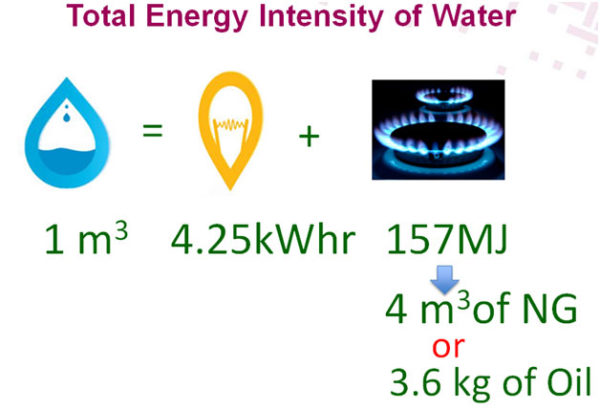
Summary & Conclusion:
The intent of this article is to show the energy intensity of water usage in GCC countries which can be a motivation for water conservation. Water conservation has social, economic and environmental benefits and it is to be considered to be top priority in building design, operation and urban planning.
References:
- KAHRAMAA Statistics report 2011
- ESCWA Water Development Report 3 Role of Desalination in addressing water scarcity
- Environmental Impacts of Seawater Desalination: Arabian Gulf Case Study, Mohamed A. Dawoud and Mohamed M. Al Mullah, International Journal of Environment and Sustainability, ISSN 1927‐9566 | Vol. 1 No. 3, pp. 22‐37 (2012)
- EPA’s Clean Energy-Environment Tech Forum “Clean Energy Opportunities in Water & Wastewater Treatment Facilities Background and Resources “, January 15, 2009
Conserve Solutions will be happy to assist your projects. Our offices are located in India, UAE, Qatar, Saudi Arabia, Canada, United Kingdom, Egypt and Singapore.
Author
-
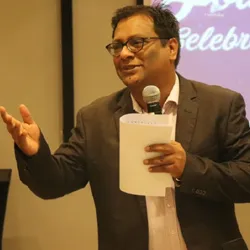
Mr. K M Bazeeth Ahamed is an USGBC LEED Faculty & consultant in Green Buildings. He has completed his Post Graduation in Mechanical Engineering from Birla Institute of Technology in 2002 and has spent 12 years in Academics, Research, MEP Contracting, Energy Audits and Green Building Consultancy.

